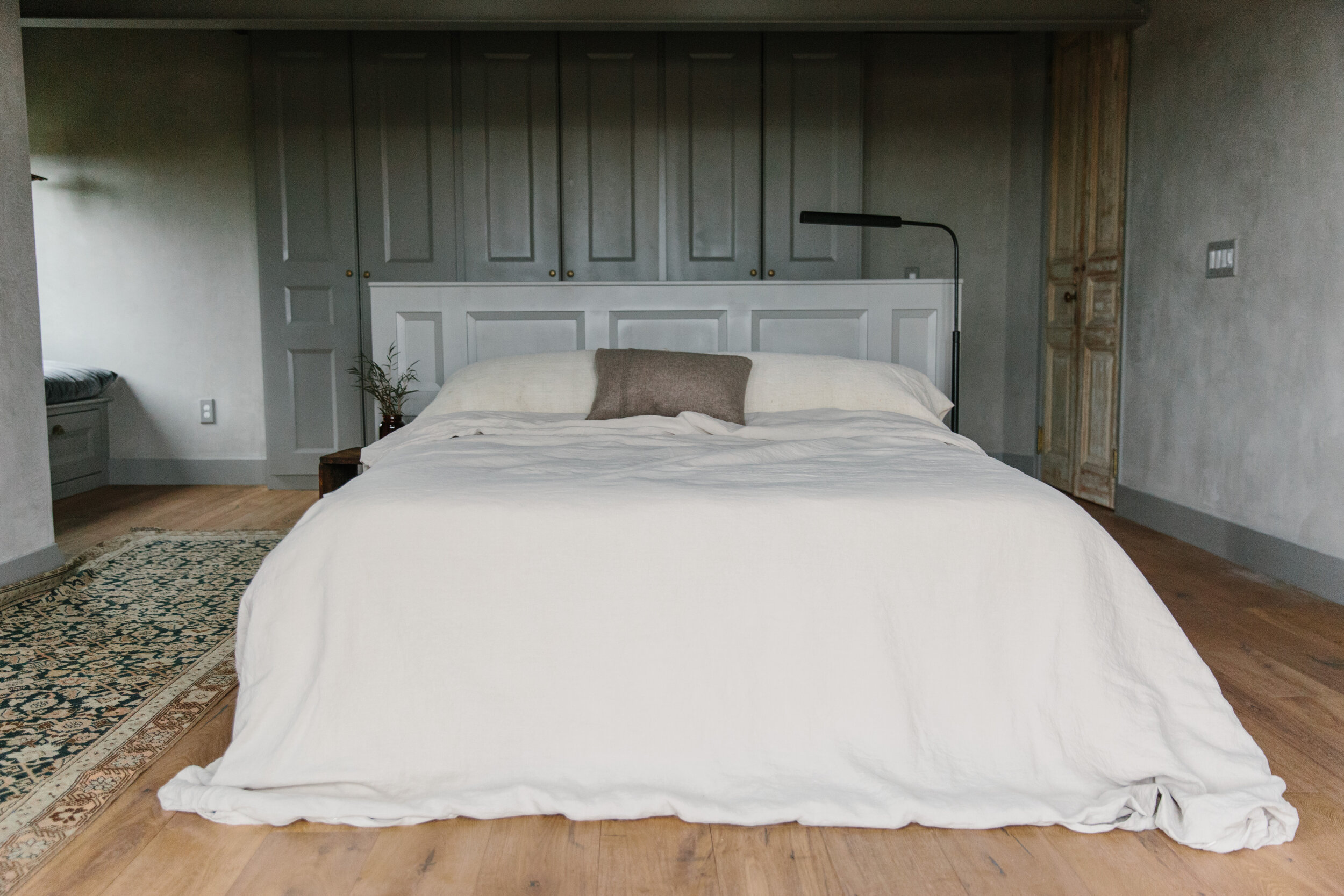Anatomy of a Moore House Bed
We’re spilling some major Moore House sleep secrets. Thanks to our guest stay cottages, we’ve perfected the art of making a bed that’s layered with all of the best textures and fabrics. We’re downright meticulous with what we include; paying attention to every little detail so you get your best nights sleep. Try our top secret formula for building your own bed from the mattress up and you’ll end up with a bed that feels as good as it looks:
Start with your bed height
In about ninety-nine percent of bedrooms the bed is a focal point, so one of the first things you should consider is how your bed sits in your room. We always skip the box spring and keep the bed height low, so a short bed frame is ideal. The mattress height should range between 9 and 13 inches, with its finished height landing somewhere around 18 to 20 inches. Why do we prefer to go low? It’s easier to get in and out of and it makes the ceilings feel higher—especially in older homes inherently low ceilings.
Add a mattress topper
For maximum comfort and support, we recommend adding a mattress topper to your bed—it gives you the fancy hotel treatment in your own bedroom. Do what works for you, we like memory foam and sometimes choose a topper with a cooling gel for clients that run hot at night. It makes sure you’re supported in all the right places! To protect the bed, we use a mattress cover to protect against wear, dirt, and stains.
You Can't beat these sheets
After the topper, it’s all about layers. We use a 750-thread count cotton sateen fitted sheet; it feels as soft as silk, but is much more breathable, and not too slippery or slick. Because of how it’s woven, its incredibly durable and ideal for people with allergies (as it combats mildew), making it a great investment. In fact, they actually get better with every wash. We’ve had some of our bedding for 30 years! A white color is our go-to option for sheets, it always looks crisp and clean.
For a top sheet, we like to mix it up with a linen counterpart. Like cotton sateen, linen is another highly durable and breathable fabric, getting softer with use. When making the bed, we always use the hospital corners; it looks really neat and crisp. We recommend putting the top sheet on upside down, that way when you add a blanket on top of it (but below the duvet), you can fold the top part of the sheet back to reveal the correct side, and then tuck everything in under the mattress.
Layer in a light blanket
We believe it’s essential to really layer the bed to accommodate peoples’ different sleeping preferences. Some people get really hot at night, and some cold, so it's important to have options that they may either fold down or snuggle more so into. We love waffle blankets, as they have a subtle loft but aren't too heavy underneath your duvet.
Top with a duvet
All of our duvet inserts have the highest amount of down (90 percent) its loftier while feathers can feel a little flatter. We like to keep our duvet covers simple, neutral colors, without patterns or anything distracting, it leaves room for finishing touches and don't want it to look too busy. Calm and relaxing is always the goal. To pair nicely with the sheets, we prefer a linen or cotton sateen material.
On the very top, we like to add a coverlet or quilt for a decorative touch, and even more added warmth if needed. Most of the time we'll use a linen quilt over the duvet, which we fold back for a finished look.
Pillows to rest your head on
Last but most certainly not least, are pillows. We like to include different types on the same bed; so the two pillows in the back are for back and side sleepers and the two in the front are for stomach sleepers. Again, it's important to have options. Our pillows are down (unless memory foam is requested by a client) and are RSD certified, meaning that the down is responsibly sourced. For full sized beds and smaller, we recommend standard sized pillows, and for queen, king and larger, we stick with king size (we use six pillows on a king size and four on a queen).
throw pillows, please!
We don’t go crazy with throw pillows, we take it on a case-by-case basis depending on the look of the rest of the room. Typically we use two twenty four-inch square throw pillows or a lumbar pillow, but we try to keep it pretty simple. Our bedding is already inviting and pretty enough.
Images: Erin McGinn and Jennifer Jeanne Photography
















The Roweam New Year’s Collection is a tribute to the art of celebration — those rare, shimmering moments when the year turns over and the home becomes the stage for gatherings, reflections, and joyious moments with loved ones. Centered around a curated ensemble of luminous glassware, art pieces, casegoods, and dining essentials, this collection captures the quiet glamour of welcoming a new chapter.